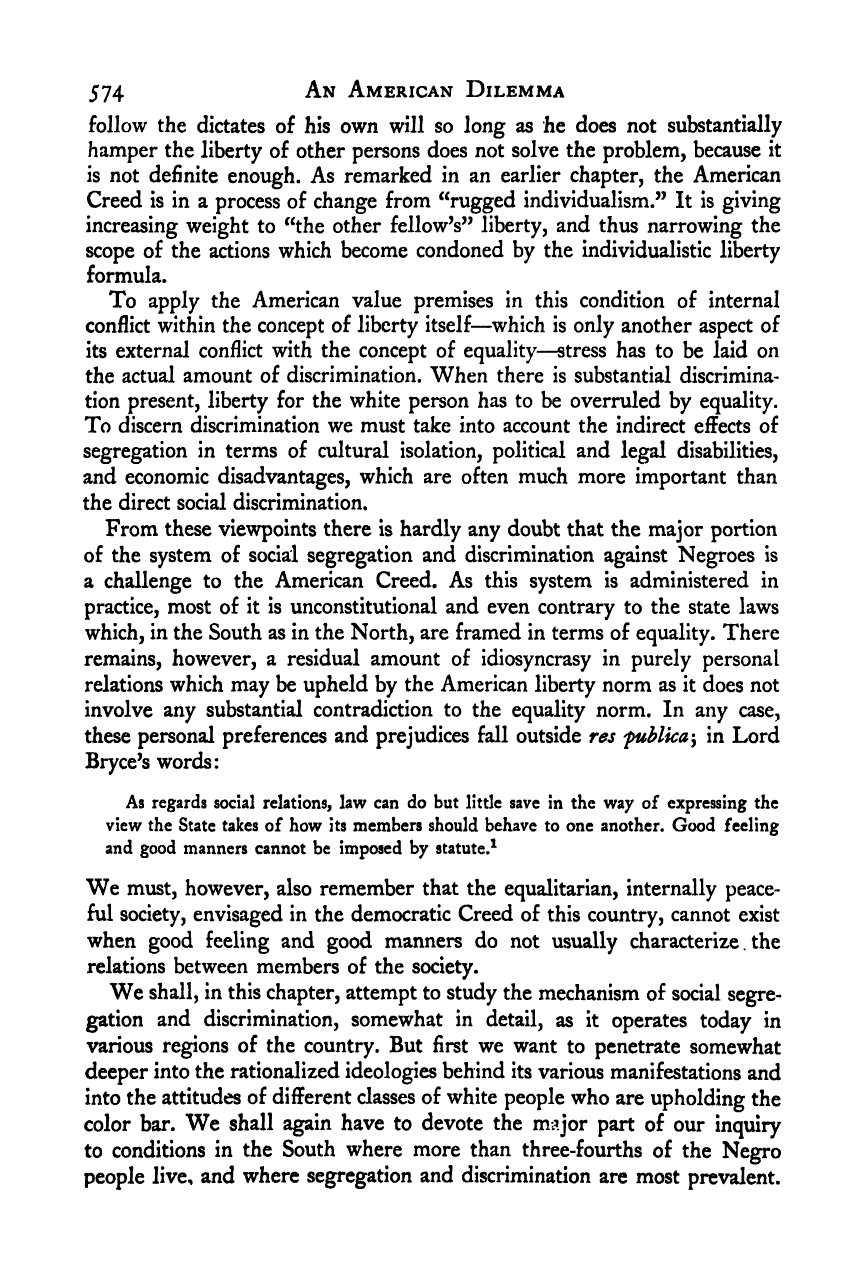Note: Gunnar Myrdal died in 1987, less than 70 years ago. Therefore, this work is protected by copyright, restricting your legal rights to reproduce it. However, you are welcome to view it on screen, as you do now. Read more about copyright.
Full resolution (TIFF) - On this page / på denna sida - VII. Social Inequality - 28. The Basis of Social Inequality - 1. The Value Premise

<< prev. page << föreg. sida << >> nästa sida >> next page >>
Below is the raw OCR text
from the above scanned image.
Do you see an error? Proofread the page now!
Här nedan syns maskintolkade texten från faksimilbilden ovan.
Ser du något fel? Korrekturläs sidan nu!
This page has never been proofread. / Denna sida har aldrig korrekturlästs.
574 An American Dilemma
follow the dictates of his own will so long as he does not substantially
hamper the liberty of other persons does not solve the problem, because it
is not definite enough. As remarked in an earlier chapter, the American
Creed is in a process of change from “rugged individualism.” It is giving
increasing weight to “the other fellowV^ liberty, and thus narrowing the
scope of the actions which become condoned by the individualistic liberty
formula.
To apply the American value premises in this condition of internal
conflict within the concept of liberty itself—which is only another aspect of
its external conflict with the concept of equality—stress has to be laid on
the actual amount of discrimination. When there is substantial discrimina-
tion present, liberty for the white person has to be overruled by equality.
To discern discrimination we must take into account the indirect effects of
segregation in terms of cultural isolation, political and legal disabilities,
and economic disadvantages, which are often much more important than
the direct social discrimination.
From these viewpoints there is hardly any doubt that the major portion
of the system of social segregation and discrimination against Negroes is
a challenge to the American Creed. As this system is administered in
practice, most of it is unconstitutional and even contrary to the state laws
which, in the South as in the North, are framed in terms of equality. There
remains, however, a residual amount of idiosyncrasy in purely personal
relations which may be upheld by the American liberty norm as it does not
involve any substantial contradiction to the equality norm. In any case,
these personal preferences and prejudices fall outside r^s ’publica\ in Lord
Bryce’s words:
As regards social relations, law can do but little save in the way of expressing the
view the State takes of how its members should behave to one another. Good feeling
and good manners cannot be imposed by statute.^
We must, however, also remember that the equalitarian, internally peace-
ful society, envisaged in the democratic Creed of this country, cannot exist
when good feeling and good manners do not usually characterize . the
relations between members of the society.
We shall, in this chapter, attempt to study the mechanism of social segre-
gation and discrimination, somewhat in detail, as it operates today in
various regions of the country. But first we want to penetrate somewhat
deeper into the rationalized ideologies behind its various manifestations and
into the attitudes of different classes of white people who are upholding the
color bar. We shall again have to devote the m.ajor part of our inquiry
to conditions in the South where more than three-fourths of the Negro
people live, and where segregation and discrimination are most prevalent.
<< prev. page << föreg. sida << >> nästa sida >> next page >>